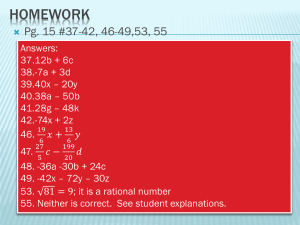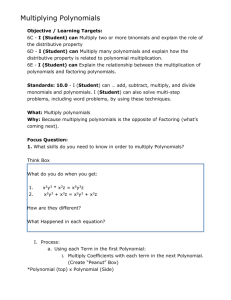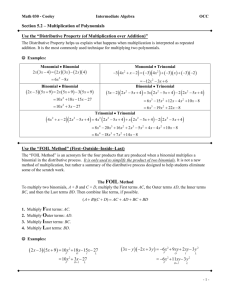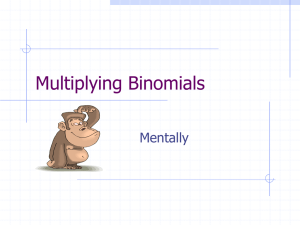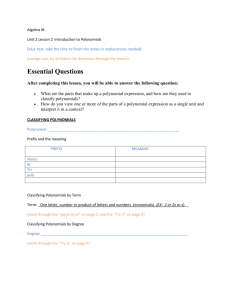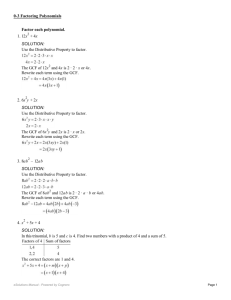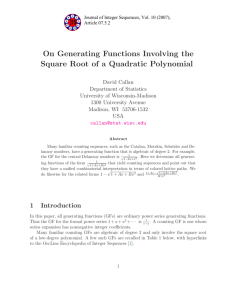Math 10 Polynomials Lesson 3 students - TangHua2012-2013
advertisement
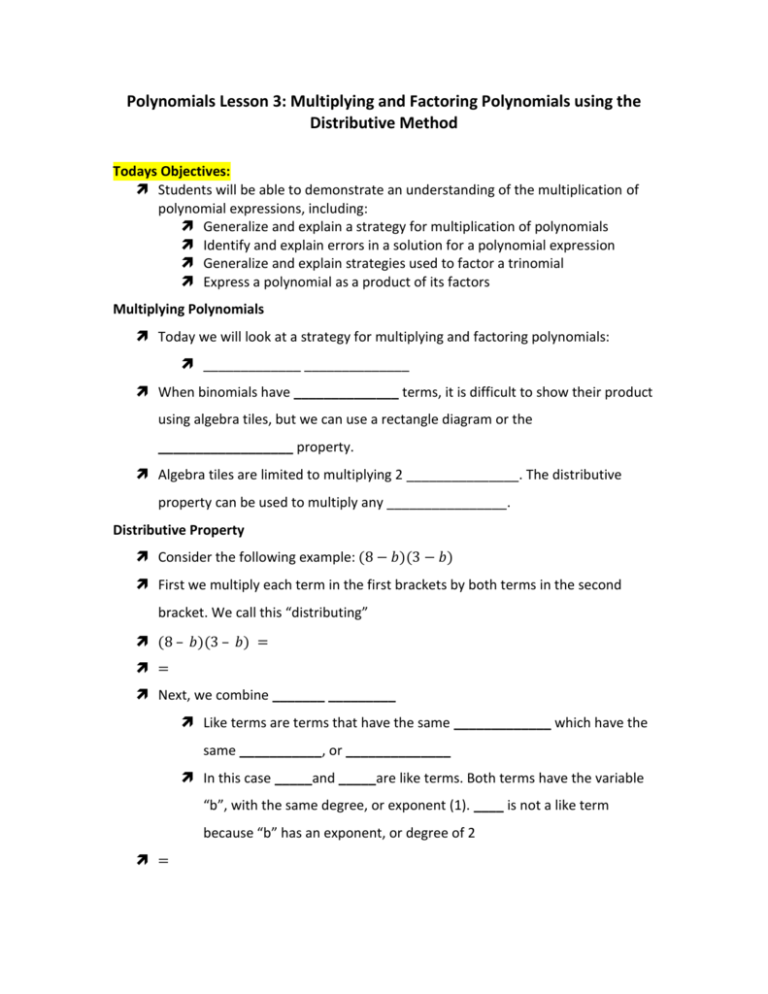
Polynomials Lesson 3: Multiplying and Factoring Polynomials using the Distributive Method Todays Objectives: Students will be able to demonstrate an understanding of the multiplication of polynomial expressions, including: Generalize and explain a strategy for multiplication of polynomials Identify and explain errors in a solution for a polynomial expression Generalize and explain strategies used to factor a trinomial Express a polynomial as a product of its factors Multiplying Polynomials Today we will look at a strategy for multiplying and factoring polynomials: _____________ ______________ When binomials have ______________ terms, it is difficult to show their product using algebra tiles, but we can use a rectangle diagram or the __________________ property. Algebra tiles are limited to multiplying 2 _______________. The distributive property can be used to multiply any ________________. Distributive Property Consider the following example: (8 − 𝑏)(3 − 𝑏) First we multiply each term in the first brackets by both terms in the second bracket. We call this “distributing” (8 – 𝑏)(3 – 𝑏) = = Next, we combine _______ _________ Like terms are terms that have the same _____________ which have the same ___________, or ______________ In this case _____and _____are like terms. Both terms have the variable “b”, with the same degree, or exponent (1). ____ is not a like term because “b” has an exponent, or degree of 2 = Example (You do) Use the distributive property to find the product of the binomials (𝑐 + 3)(𝑐 + 5) Solution: Notice from the trinomial: 8 is the _______ of 3 and 5 15 is the __________ of 3 and 5 The leading _______________ of the trinomial is 1, as are the leading coefficients of the binomial factors Example Factor the trinomial x2 – 4x – 21 into two binomials. Answer will be in the form (x + a)(x + b), where we know the following: So we need to find two numbers that ______ to -4, and ______________ to -21 Find all factors of -21 Find one set of factors that add to -4 So, a = ___, b = ___ Example (You do) Factor the trinomial z2 – 12z + 35 Solution: Example List all the factors for the polynomial 2x2 – 10x + 12 Solution: First, remove the _______ *you must include the factored out 2 as a factor in your final answer! Now, factor the trinomial: Find all the factors of +6 Find one set of factors that add to – 5 So, a = ____, b = _____ Factors of the polynomial 2x2 – 10x + 12 are: Example (You do) Factor -4t2 – 16t + 128 Solution: The _____________ ___________ can be used to perform any polynomial multiplication. Each term of one polynomial must be ____________ by each term of the other polynomial. Using the distributive property to multiply two polynomials Multiply (2h + 5)(h2 + 3h – 4) Solution:Multiply each term in the trinomial by each term in the binomial. Write the terms in a list. = (2ℎ)(ℎ2 + 3ℎ – 4) + 5(ℎ2 + 3ℎ – 4) Example:(-3f2 + 3f – 2)(4f2 – f – 6) Solution: Use the distributive property. Multiply each term in the 1st trinomial by each term in the 2nd trinomial. ______like terms. Check:One way to check that your product is correct is to ________ a ________ for the ___________ in both your answer and the original question. If both sides are _______, then your answer is correct. For this example, let’s let f = 1. Since the left side _________ the right side, the product is likely correct. Example (You do) Use the distributive property to multiply. (3x – 2y)(4x – 3y + 5) Solution: Example:Simpify (2c – 3)(c + 5) + 3(c – 3)(-3c + 1) Solution: Use the ________ ___________ ________. Multiply before adding and subtracting. Then, ____________ like terms. Example (You do): (3x + y – 1)(2x – 4) – (3x + 2y)2 Solution: Homework: pg. 186-187, # 5,7,9,11,15-17, 21

